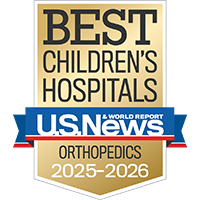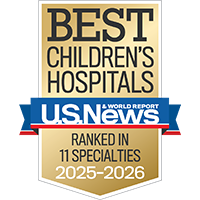Saving future lives
500+ UCSF investigators are researching cures for hundreds of childhood and adult diseases.


In-toeing means the feet turn toward each other (instead of pointing straight ahead) when a child walks or runs. Also known as being pigeon-toed, in-toeing is actually a normal stage in childhood development. In more than 95% of children with in-toeing, the lower limbs gradually rotate out on their own until about 10 years of age. At this point, the adult shape of the legs is set and no further improvement can be expected. In-toeing almost always gets better on its own and doesn't pose a problem during childhood – or adulthood.
Out-toeing, or being duck-footed, means the feet point outward instead of straight ahead when a child walks or runs. It can also be a normal part of development. However, because the lower limbs tend to rotate further outward with growth, out-toeing may stay the same or become more pronounced as the child matures.
In severe cases, the rotation of the legs and feet is so extreme that the child has difficulty running, playing and participating in normal childhood activities. Out-toeing is more likely to cause problems than in-toeing. In fact, in-toeing may be a functional advantage – athletes tend to be pigeon-toed more often than the general population.
In addition, children may perceive severe in-toeing or out-toeing as embarrassing or unattractive, which can have negative effects on body image and self-esteem. While it may be more widely accepted to treat these conditions for functional reasons, we believe appearance concerns need to be factored into treatment decisions as well.
In-toeing and out-toeing are often caused by a slight rotation of the upper or lower leg bones. This can occur for several reasons.
In-toeing may be caused by:
Out-toeing may be caused by:
Because in-toeing corrects itself in 95% of children by the time they’re 10 years old, those who have it are simply observed, usually by their pediatricians, until they reach that age. This allows normal development to take its course, while the provider keeps a lookout for potential problems.
If significant in-toeing or out-toeing persists, you may want to consult a pediatric orthopedic surgeon.
A surgical procedure called rotational osteotomy is the only intervention that can alter alignment of the lower limbs in a child with in-toeing or out-toeing. Braces, special shoes and physical therapy aren't effective.
In a rotational osteotomy, the thigh bone (femur) or bones of the lower leg (tibia and fibula) are cut and rotated so that the feet align properly. Metal implants – typically pins or a plate and screws – keep the bones in place while they heal in their new orientation.
Rotational osteotomy is a major operation. Possible complications include:
Although surgery is the only way to change severe in-toeing or out-toeing, the benefits must be carefully weighed against the risks for each child.
UCSF Benioff Children's Hospitals medical specialists have reviewed this information. It is for educational purposes only and is not intended to replace the advice of your child's doctor or other health care provider. We encourage you to discuss any questions or concerns you may have with your child's provider.

One of the nation's best for orthopedics

Ranked among the nation's best in 11 specialties
Saving future lives
